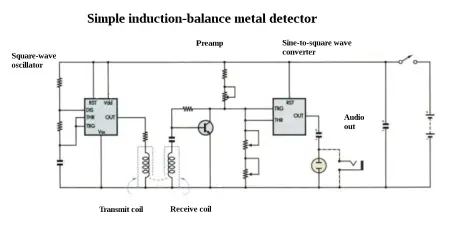The sensor assembly of a metal detector consists of one or more coils, usually two. An oscillator outputs an alternating current that passes through the send coil, producing a fluctuating magnetic field that penetrates the ground or other layer that is opaque to visible light.
The fluctuating magnetic field induces eddy currents in any conductive material that is within range. These eddy currents, in turn, produce another magnetic field, which causes current to flow in the receive coil. The induced current can be amplified and directed to earphones or a gauge and the operator can interpret the display to ascertain the size, depth and nature of the material.
This system can discriminate between metals every metal has a different phase response when exposed to ac. However, some metals (such as tin foil and gold) have similar phase responses. Thus, improper tuning can increase the risk of passing over a valuable find.
A discriminator, or differentiator as it is also called cancels the signal generated by unwanted metals and ground mineralization. It can be made more or less aggressive by adjusting a knob on the control panel. A difficulty is that if this function is set too high, the signal from a gold coin or other valuable object may be rejected. Similarly the overall sensitivity can be adjusted.
The operator can adjust settings and learn to interpret the metal detector output by intentionally burying silver, copper, gold, aluminum, iron and other objects at measured depths and seeing how the instrument reacts.

The original induction balance coil system consisted of two identical coils located on top of one another. Alternatives include two coils in a D shape, mounted back-to-back to form a circle. Another improvement was detectors which could cancel out the effect of mineralization in the ground.
Another kind of metal detector uses pulse induction. Beat-frequency oscillator and induction-balance machines both use a uniform ac signal at a low frequency. In contrast, the pulse induction machine magnetizes the ground with a relatively powerful, momentary current through a search coil. In the absence of metal, the field decays at a uniform rate. Measuring the time it takes to fall to zero volts gives a reading indicating no metal present. If metal is present when the machine fires, a small eddy current will be induced in the metal and the time for sensed current decay rises. Though these time differences are minute, modern electronics can measure them accurately and identify the presence of metal at reasonable distances. Pulse machines are also mostly impervious to the effects of mineralization.
Metal detectors are used to find valuable coins, lost objects, archeological artifacts, bullets and other metal objects in wounded patients, concealed guns and bombs at public access points, subterranean mineral deposits, underground pipes and electrical cables, rebar embedded in concrete and other conductive objects of interest.
A portion of Florida’s eastern seaboard consists of sandy beaches known as the Treasure Coast. It is a few miles south of the Kennedy Space Center. In 1715, eleven Spanish ships perished in a fierce hurricane offshore near Vero Beach, Florida. They had departed seven days earlier from Havana, Cuba, and were on their way to Spain carrying an enormous amount of silver and gold coins. Some of them, along with other artifacts, are continually washed ashore 300 years later. Many of them remain under a thin layer of sand.
At low tide, especially after a strong storm, metal detecting enthusiasts can be seen making their way along Treasure Coast beaches attempting to locate and recover Spanish Doubloons and other valuable objects. It is not uncommon for them to recover a gold coin or piece of silver, although often a day’s hard work is unrewarded. One problem is the presence of “tramp” metal objects. These are iron and aluminum junk objects, such as beer can tabs, which are of no value. Premium metal detectors are capable of discriminating between different classes of objects, rejecting iron, for example.

the best metal detectors is working with imaging system because it give you most real results
http://www.groundnavigator.com/